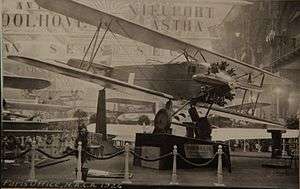Avia BH-26
| BH-26 | |
|---|---|
 | |
| Role | Reconnaissance aircraft |
| Manufacturer | Avia |
| Designer | Pavel Beneš and Miroslav Hajn |
| First flight | 1927 |
| Number built | ca. 8 |
|
| |
The Avia BH-26 was a two-seat armed reconnaissance aircraft built in Czechoslovakia in 1927. It was a single-bay unstaggered biplane with equal-span wings and a fixed tail-skid undercarriage. Both upper and lower wings featured long-span ailerons, which were dynamically balanced by a small auxiliary airfoil mounted to the upper surface of the lower ailerons. Its design was typical of this type of aircraft built during World War I and the years following; pilot and observer in tandem open cockpits with the observer armed with a machine gun on a ring mount. As with many other Avia designs, the BH-26 originally had no fixed fin; only a rudder, but this was changed in service.
Specifications
General characteristics
- Crew: two, pilot and observer
- Length: 8.85 m (29 ft 0 in)
- Wingspan: 10.80 m (35 ft 5 in)
- Height: 3.35 m (11 ft 0 in)
- Wing area: 31.0 m2 (333 ft2)
- Empty weight: 1,030 kg (2,270 lb)
- Gross weight: 1,630 kg (3,590 lb)
- Powerplant: 1 × Walter-built Bristol Jupiter IV radial, 336 kW (450 hp)
Performance
- Maximum speed: 242 km/h (150 mph)
- Range: 530 km (330 miles)
- Service ceiling: 8,500 m (27,900 ft)
- Rate of climb: 6.3 m/s (1,230 ft/min)
Armament
- 2 × fixed, forward-firing 7.7 mm (.303 in) Vickers machine guns
- 2 × 7.7 mm (.303 in) Lewis guns in Skoda-built ring mount for observer
See also
- Related development
References
| Wikimedia Commons has media related to Avia BH-26. |
- Taylor, Michael J. H. (1989). Jane's Encyclopedia of Aviation. London: Studio Editions. p. 86.
- World Aircraft Information Files. London: Bright Star Publishing. pp. File 889 Sheet 86.
- Němeček, V. (1968). Československá letadla. Praha: Naše Vojsko.
This article is issued from Wikipedia - version of the 6/23/2015. The text is available under the Creative Commons Attribution/Share Alike but additional terms may apply for the media files.